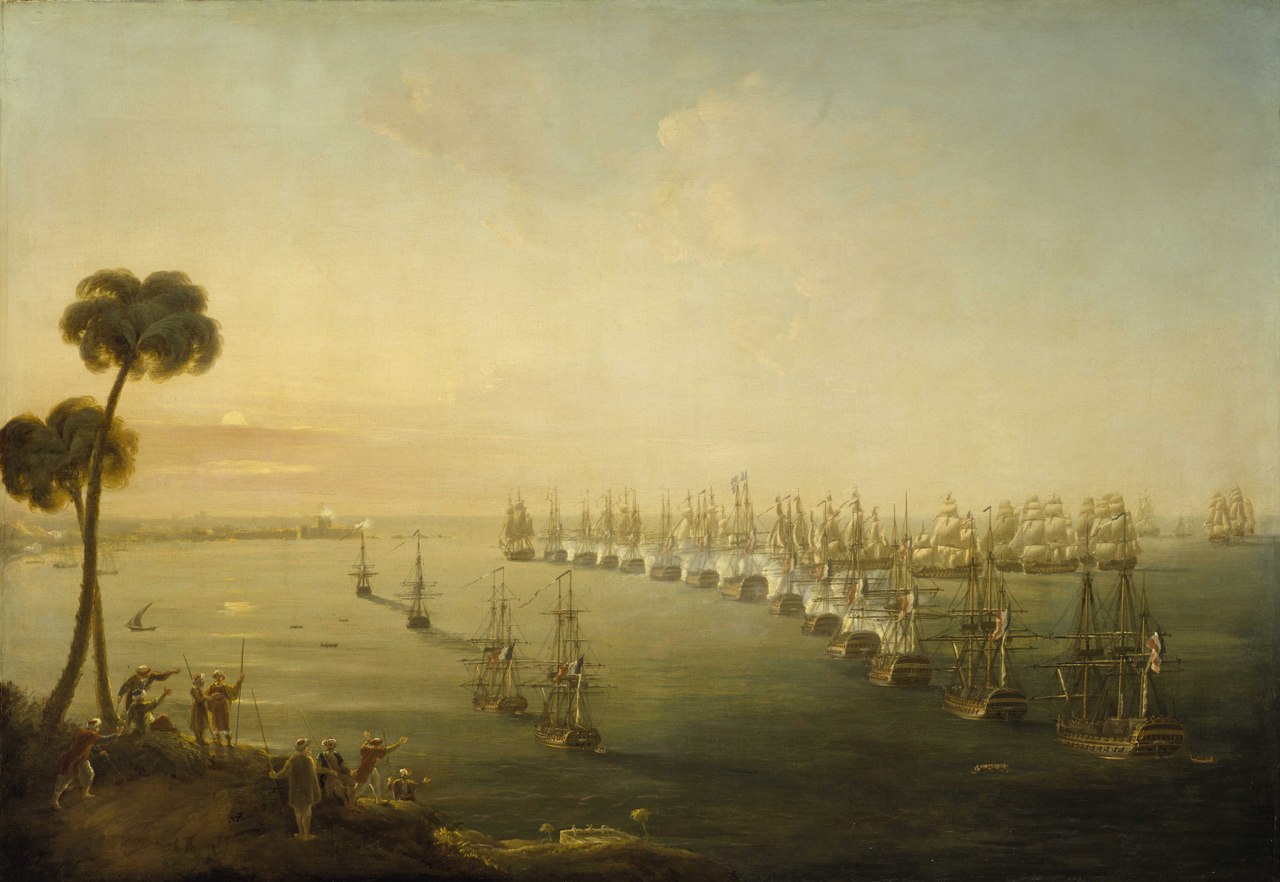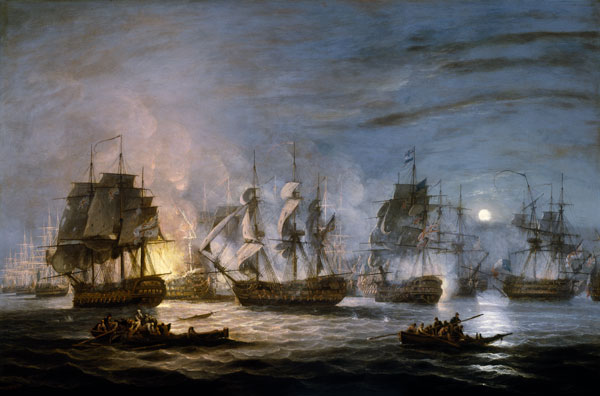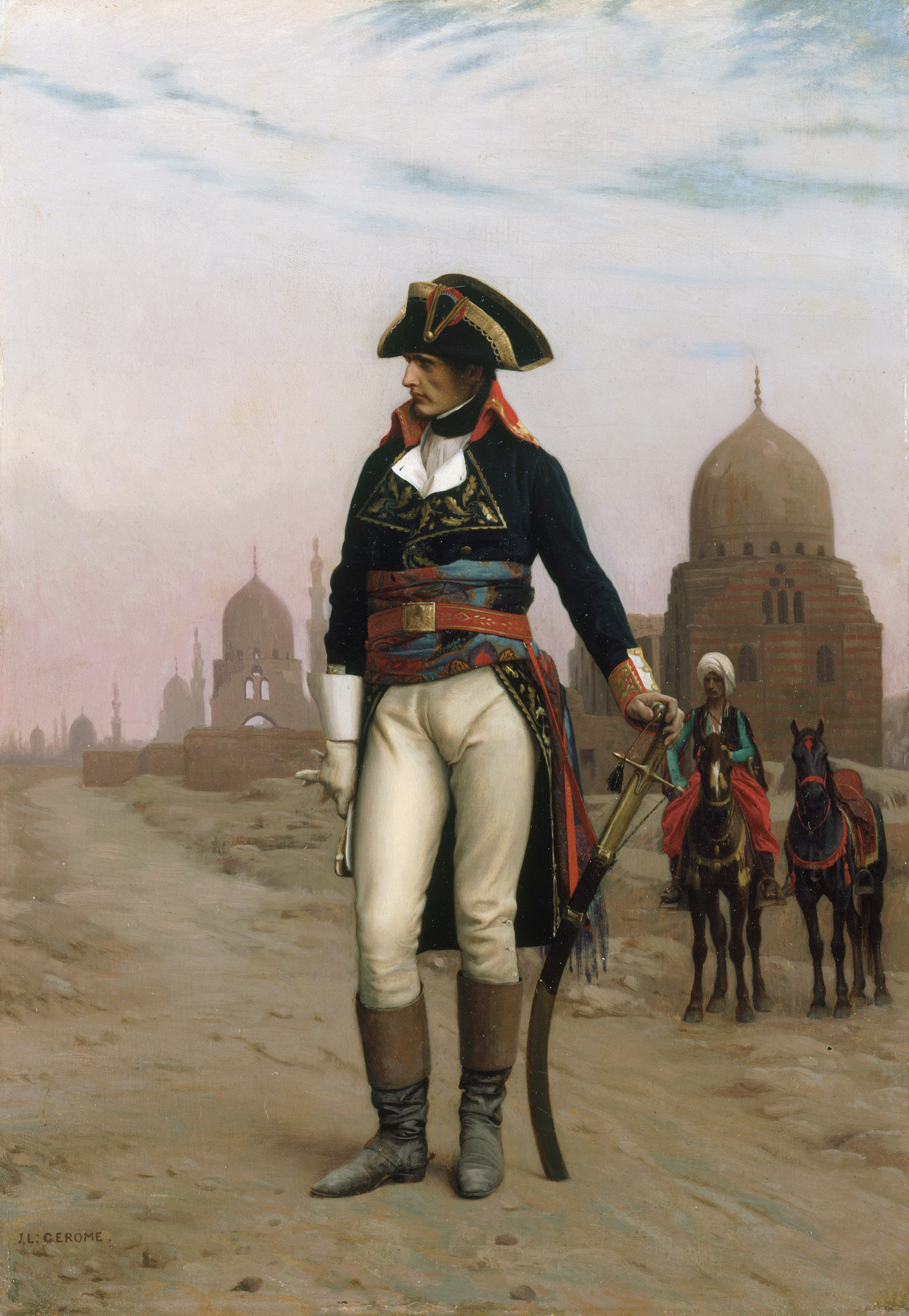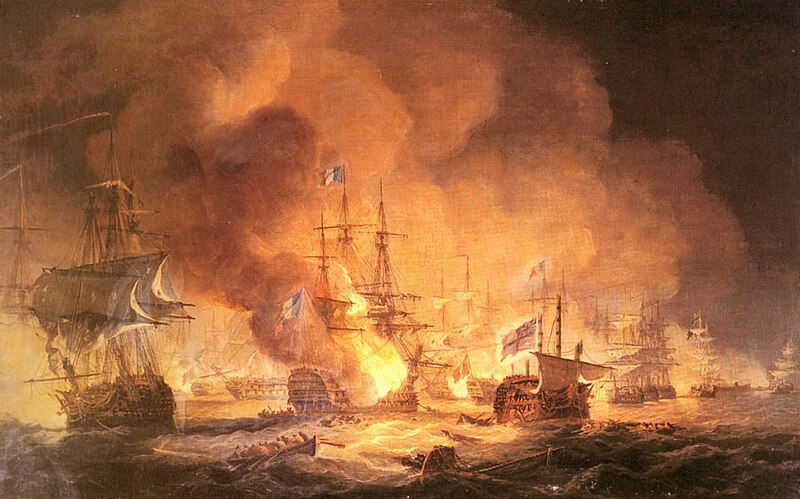Rumors became rife as 40,000 soldiers and 10,000 sailors were gathered in French Mediterranean ports. A large fleet was assembled at Toulon: 13 ships of the line, 14 frigates, and 400 transports. To avoid interception by the British fleet under Nelson, the expedition's target was kept secret. It was known only to Bonaparte himself, his generals.

The French Revolution had significantly reduced the Knights of Malta's income and their ability to put up serious resistance. Half of the Knights were French, and most of these knights refused to fight.

Charles Etienne Pierre Motte was a French lithographers and publisher during the first half of the 19th century, (1785 - 1836).
French troops disembarked in Malta at seven points on the morning of 11 June. Gen. Louis Baraguey d'Hilliers landed soldiers and cannon in the western part of the main island of Malta, under artillery fire from Maltese fortifications. The French troops met some initial resistance but pressed forward. The Knights' ill-prepared force in that region, numbering only about 2,000, regrouped. The French pressed on with their attack. After a fierce gun battle lasting twenty-four hours, most of the Knights' force in the west surrendered.

Sir William Quiller Orchardson RA (Edinburgh 27 March 1832 – 13 April 1910 London) was a noted Scottish portraitist and painter of domestic and historical subjects who was knighted in June 1907, at the age of 75. More
Napoleon then opened negotiations. Faced with vastly superior French forces and the loss of western Malta, von Hompesch surrendered the main fortress of Valletta.

Thirteen days after leaving Malta and continuing to successfully elude detection by the Royal Navy for the time being, the fleet was in sight of Alexandria, where it landed on 1 July, though his plan had been to land elsewhere.

Guillaume François Colson, (1785–1850), a French historical painter,was born in Paris in 1785, and died there in 1860.
Bonaparte left Alexandria on 6 July. General Dugua marched on Rosetta, with orders to seize and hold the entrance to the port housing the French fleet, which had to follow the route to Cairo down the river's left bank and rejoin the army at Rahmanié. On 8 July, Bonaparte arrived at Demenhour, where he found the forces had met up, and awaited the fleet with their provisions. The fleet arrived on 12 July and the army began to march again at night, followed by the fleet.
Sudden heavy winds forced the fleet to the army's left and straight into the enemy fleet, which was supported by musket fire from 4,000 Mamluks, reinforced by peasants and Arabs. The French fleet had numerical superiority but still lost its gunboats to the enemy. Attracted by the sound of gunfire, Bonaparte ordered his land force to the charge and attacked the village of Chebreiss, which was captured after two hours of fierce fighting. The enemy fled in disorder towards Cairo, leaving 600 dead on the battlefield.
Louis-François, Baron Lejeune (3 February 1775, Strasbourg – 29 February 1848) was a French general, painter, and lithographer. His memoirs have frequently been republished and his name is engraved on the Arc de Triomphe. More
After a day's rest at Chebreiss, the French land force continued the pursuit. On 20 July, it arrived half a mile from the village of Embabé. There Bonaparte drew up his 25,000 troops for battle approximately nine miles (15 km) from the Pyramids of Giza.

Wojciech Kossak (Paris, France, December 31, 1856 – July 29, 1942, Kraków, Poland) was a Polish painter and member of the celebrated Kossak family of painters and writers. More
This was the start of the so-called Battle of the Pyramids, also known as the Battle of Embabeh, a French victory over an enemy force of about 21,000 Mamluks. The French defeated the Mamluk cavalry with a giant infantry square, with cannons and supplies safely on the inside. In all 300 French and approximately 6,000 Egyptians were killed. The battle gave rise to dozens of stories and drawings.








Thomas Luny (1759–1837), born in Cornwall, probably at St Ewe, was an English artist and painter, mostly of seascapes and other marine-based works.
After the naval defeat at Aboukir, Bonaparte's campaign remained land-bound. However, his army still succeeded in consolidating power in Egypt, although it faced repeated nationalist uprisings, and Napoleon began to behave as absolute ruler of all Egypt.

In a largely unsuccessful effort to gain the support of the Egyptian population, Bonaparte issued proclamations that cast him as a liberator of the people from Ottoman and Mamluk oppression, praising the precepts of Islam and claiming friendship between France and the Ottoman Empire.

Anne-Louis Girodet de Roucy-Trioson, (January 5, 1767 – December 9, 1824) was a French painter and pupil of Jacques-Louis David, who was part of the beginning of the Romantic movement by adding elements of eroticism through his paintings. Girodet is remembered for his precise and clear style and for his paintings of members of the Napoleonic family. More
This could however not prevent the growing anti-French sentiments because the use of alcohol and unveiling of woman was introduced to a muslim community. Ultimately this led to a revolt in which the ‘infidels’ were to be slaughtered. Napoleon drove the insurgents back to the main mosque of Caïro using his artillery.
The French forces killed thousands of Egyptians and to restore order, Napoleon executed some surviving insurgents with public beheadings. French losses of 300 soldiers still were minimal compared to the Egyptian losses. While secretly the remaining prisoners in Cairo were beheaded and thrown in the river at night, Napoleon granted pardon to local sheiks and imans of the El Azhar mosque speaking the words : “I know that many of you have been weak, but I like to believe that none of you is guilty”.

Despite all the important scientific work that was done by his scientists with the discovery of the Rosetta stone as a major contribution to egyptology, they made one big mistake in estimating the feasability of constructing the Suez canal. The team assumed a height difference between the red sea and the mediterranean water level which would endanger the Egyptian delta with flooding in case of a direct connection.
When the Ottomans in Constantinople received news of the French fleet's destruction at Aboukir, they believed this spelled the end for Bonaparte and his expedition. Sultan Selim III decided to wage war against France, and sent two armies to Egypt. The Ottomans planned two offensives against Cairo: from Syria, across the desert of Salhayeh-Belbays-El Kankah, and from Rhodes by sea landing in the Aboukir area or the port city of Damietta.
Part II
Acknowledgement: Wikipedia, 19th Century Realism,

Pierre Martinet (1781-?)
Boarding of the French army in Toulon to Egypt
Left: Bonaparte and his generals. 1798.
MARTINET, Pierre (born 1781). French Painter. Military subjects, scenes with figures. A student of Jacques Swebach, he submitted works to the Paris Salon from 1808 to 1812. He painted battle scenes and popular or fashionable subjects, treated in a lively way but also sometimes with a degree of confusion. More
On 19 May. Bonaparte's fleet embarked, from Toulon headed for Malta. When the fleet arrived off Malta, Napoleon demanded that the Knights of Malta allow his fleet to enter the port and take on water and supplies. The island of Malta was an important strategic stronghold in the Mediterraenean Sea and Napoleon Bonaparte knew that controlling it would boost France's naval capacity in the region, particularly with the British Mediterranean Fleet under Admiral Horatio Nelson anchored in nearby Sicily.
The invading French fleet at Malta, 1798
Grand Master von Hompesch replied that only two foreign ships would be allowed to enter the port at a time. Under that restriction, revictualling the French fleet would take weeks, and it would be vulnerable to the British fleet of Admiral Nelson. Napoleon therefore ordered the invasion of Malta.
The French Revolution had significantly reduced the Knights of Malta's income and their ability to put up serious resistance. Half of the Knights were French, and most of these knights refused to fight.

Charles Etienne Pierre Motte (1785 - 1836)
Debarquement a l'Ile de Malte (Bonaparte landing on Malta)
Hand-coloured.; Medium includes gum arabic.
lithograph, coloured
399 mm x 517 mm
National Maritime Museum, Greenwich, London
Charles Etienne Pierre Motte was a French lithographers and publisher during the first half of the 19th century, (1785 - 1836).
French troops disembarked in Malta at seven points on the morning of 11 June. Gen. Louis Baraguey d'Hilliers landed soldiers and cannon in the western part of the main island of Malta, under artillery fire from Maltese fortifications. The French troops met some initial resistance but pressed forward. The Knights' ill-prepared force in that region, numbering only about 2,000, regrouped. The French pressed on with their attack. After a fierce gun battle lasting twenty-four hours, most of the Knights' force in the west surrendered.

Sir William Quiller Orchardson 1832–1910
Napoleon on Board the Bellerophon 1880
Oil paint on canvas
1651 x 2489 mm
Tate
Sir William Quiller Orchardson RA (Edinburgh 27 March 1832 – 13 April 1910 London) was a noted Scottish portraitist and painter of domestic and historical subjects who was knighted in June 1907, at the age of 75. More
Napoleon then opened negotiations. Faced with vastly superior French forces and the loss of western Malta, von Hompesch surrendered the main fortress of Valletta.

Capture of Malta by General Bonaparte, commanding the French fleet, June 12, 1798.
Guillaume-François Colson (1785–1850)
Feeder Napoleon In Alexandria On 3 July 1798 His grace towards an Arab family
c. 1812
Oil on canvas
365 × 500 cm (143.7 × 196.9 in)
National Museum of Versailles
Guillaume François Colson, (1785–1850), a French historical painter,was born in Paris in 1785, and died there in 1860.
Bonaparte left Alexandria on 6 July. General Dugua marched on Rosetta, with orders to seize and hold the entrance to the port housing the French fleet, which had to follow the route to Cairo down the river's left bank and rejoin the army at Rahmanié. On 8 July, Bonaparte arrived at Demenhour, where he found the forces had met up, and awaited the fleet with their provisions. The fleet arrived on 12 July and the army began to march again at night, followed by the fleet.
Sudden heavy winds forced the fleet to the army's left and straight into the enemy fleet, which was supported by musket fire from 4,000 Mamluks, reinforced by peasants and Arabs. The French fleet had numerical superiority but still lost its gunboats to the enemy. Attracted by the sound of gunfire, Bonaparte ordered his land force to the charge and attacked the village of Chebreiss, which was captured after two hours of fierce fighting. The enemy fled in disorder towards Cairo, leaving 600 dead on the battlefield.
Louis-François, Baron Lejeune (1775–1848)
The Battle of the Pyramids, 1808
Oil on canvas
National Museum of Versailles
Louis-François, Baron Lejeune (3 February 1775, Strasbourg – 29 February 1848) was a French general, painter, and lithographer. His memoirs have frequently been republished and his name is engraved on the Arc de Triomphe. More
After a day's rest at Chebreiss, the French land force continued the pursuit. On 20 July, it arrived half a mile from the village of Embabé. There Bonaparte drew up his 25,000 troops for battle approximately nine miles (15 km) from the Pyramids of Giza.

Wojciech Kossak (1857–1942)
Battle of the Pyramids
Date 1896
Oil on canvas
70 × 105 cm (27.6 × 41.3 in)
Current location
National Museum in Warsaw
Wojciech Kossak (Paris, France, December 31, 1856 – July 29, 1942, Kraków, Poland) was a Polish painter and member of the celebrated Kossak family of painters and writers. More
This was the start of the so-called Battle of the Pyramids, also known as the Battle of Embabeh, a French victory over an enemy force of about 21,000 Mamluks. The French defeated the Mamluk cavalry with a giant infantry square, with cannons and supplies safely on the inside. In all 300 French and approximately 6,000 Egyptians were killed. The battle gave rise to dozens of stories and drawings.

Francois-Louis-Joseph Watteau (1758–1823)
The Battle of the Pyramids
c. 1798-1799
Oil on canvas
94 × 120.4 cm (37 × 47.4 in)
Museum of Fine Arts, Valenciennes
François Louis Joseph Watteau (18 August 1758, Lille – 1 December 1823, Lille), known like his father as the Watteau of Lille, was a French painter, active in his birthplace. From 1808 to his death he was deputy curator of the Palais des Beaux-Arts de Lille, which his father had helped to found. More
Battle of the Pyramids, July 21, 1798
c. 1810
Oil on canvas 389 x 311 cm
National Museum of Versailles
Antoine-Jean Gros (16 March 1771 – 25 June 1835), Baron Gros, also known as Jean-Antoine Gros, was both a French history and neoclassical painter. More
Before the Sphinx 1867-1868
Oil on canvas
Hearst Castle
On 22 July, the notables of Cairo came to Giza to meet Bonaparte and offered to hand over the city to him. Three days later, he moved his main headquarters there.

Léon Cogniet (1794–1880)
The 1798 Egyptian Expedition Under the Command of Bonaparte
Date 1835
Oil on canvas
Ceiling at the Musée du Louvre
Léon Cogniet (29 August 1794, Paris – 20 November 1880, Paris) was a French history and portrait painter. He is probably best remembered as a teacher, with over one hundred well-known students. More
On 1 August Nelson discovered the French warships anchored in a strong defensive position in the Bay of Abukir. The French believed that they were open to attack only on one side, the other side being protected by the shore.

Thomas Whitcombe (1763–1824)
The opening stages of the Battle of the Nile, 1798.
1 March 1816; published: 1817
Color aquatint
21.5 × 30 cm (8.5 × 11.8 in)
National Maritime Museum
Thomas Whitcombe (possibly 19 May 1763 – circa 1824) was a prominent British maritime painter of the Napoleonic Wars. Among his work are over 150 actions of the Royal Navy, and he exhibited at the Royal Academy, the British Institution and the Royal Society of British Artists. More

Nicholas Pocock (1741–1821)
The Battle of the Nile, 1 August 1798
c. 1808
Oil on canvas
71.12 × 101.2 cm (28 × 39.8 in)
National Maritime Museum
Nicholas Pocock (2 March 1740 – 9 March 1821) was a British artist known for his many detailed paintings of naval battles during the age of sail. More
However, during the Battle of the Nile the arriving British fleet under Horatio Nelson managed to slip half of their ships in between the land and the French line, thus attacking from both sides. In a few hours 11 out of the 13 French ships of the line and 2 out of the 4 French frigates were captured or destroyed; the four remaining ships fled.

Daniel Orme (1766-circa 1832)
Nelson coming on deck at the battle of the Nile, 1 August 1798
circa 1800
Oil on canvas
149.86 × 198.12 cm (59 × 78 in)
National Maritime Museum
Daniel Orme (1766–circa 1832) was an artist in England. He was born in Manchester in 1766. His father encouraged his interest in an artistic career. From 1785 to 1814 he lived in London, during which he studied at the Royal Academy. He became a painter and engraver in London. In 1814 he moved back to Manchester. He has two paintings in the National Maritime Museum. More

Thomas Luny (1759–1837)
The Battle of the Nile, August 1st 1798
c. 1830
Oil on canvas
84 × 128 cm (33.1 × 50.4 in)
Thomas Luny (1759–1837), born in Cornwall, was an English artist and painter, mostly of seascapes and other marine-based works. Specimens of his work are exhibited at the National Maritime Museum at Greenwich, in the Royal Albert Memorial Museum in Exeter, and at The Mariners' Museum in Newport News, Virginia. More

George Arnald (1763 – 1841)
The Destruction of "L'Orient" at the Battle of the Nile, 1 August 1798
c. 1825-27
Oil on canvas
185.5 × 269 cm (73 × 105.9 in)
National Maritime Museum
George Arnald ARA (1763 – 21 November 1841) was a British painter who specialised in landscapes, including topographical views to illustrated county histories. He is best known for his celebrated painting depicting the Battle of the Nile. More

Mather Brown (1761–1831)
A painting of the height of the Battle of the Nile, 1798
Date 1825
Oil on canvas
103.4 × 123.2 cm (40.7 × 48.5 in)
National Maritime Museum
Mather Brown (baptized October 11, 1761 – May 25, 1831) was a portrait and historical painter, born in Boston, Massachusetts, but active in England. More
This frustrated Bonaparte's goal of strengthening the French position in the Mediterranean Sea, and instead put it totally under British control.


Thomas Luny (1759–1837)
Battle of the Nile, August 1st 1798 at 10 pm, c. 1834
Oil on canvas
70.5 × 45 cm (27.8 × 17.7 in)
Philip James de Loutherbourg (1740–1812)
The Battle of the Nile
National Maritime Museum
After the naval defeat at Aboukir, Bonaparte's campaign remained land-bound. However, his army still succeeded in consolidating power in Egypt, although it faced repeated nationalist uprisings, and Napoleon began to behave as absolute ruler of all Egypt.

Jean-Léon Gérôme (1824–1904)
General Bonaparte in Cairo
Napoleon in Egypt
circa 1863
Oil on panel
35.8 × 25 cm (14.1 × 9.8 in)
Princeton University Art Museum
In a largely unsuccessful effort to gain the support of the Egyptian population, Bonaparte issued proclamations that cast him as a liberator of the people from Ottoman and Mamluk oppression, praising the precepts of Islam and claiming friendship between France and the Ottoman Empire.
Alexandre-Marie Colin
Napoleon Bonaparte (1769-1821) Celebrating the Birthday of the Prophet Mohammed during his Campaign on Egypt (1798-1801)
Alexandre-Marie Colin, (1798-1875) a French painter of historical and genre subjects, was born in Paris in 1798. He was a pupil of Girodet. His religious and historical paintings are characterised by a style based on a careful study of the old masters, while his genre pieces are vigorous and lifelike. Amongst these latter may be noticed his 'French Fish-Market' (1832) in the Berlin Gallery, and his 'Gipsies Resting.' Amongst the former may be named a 'Christopher Columbus,' a 'Flight into Egypt,' and an 'Assumption of the Virgin.' He died in 1875. More

Anne-Louis Girodet de Roussy-Trioson, French, 1767-1824
The Revolt of Cairo
c. 1810
Oil and ink on paper, laid down on canvas
12 1/8 x 17 3/4 in. (30.8 x 45.1 cm)
Art Institute of Chicago
Anne-Louis Girodet de Roucy-Trioson, (January 5, 1767 – December 9, 1824) was a French painter and pupil of Jacques-Louis David, who was part of the beginning of the Romantic movement by adding elements of eroticism through his paintings. Girodet is remembered for his precise and clear style and for his paintings of members of the Napoleonic family. More
This could however not prevent the growing anti-French sentiments because the use of alcohol and unveiling of woman was introduced to a muslim community. Ultimately this led to a revolt in which the ‘infidels’ were to be slaughtered. Napoleon drove the insurgents back to the main mosque of Caïro using his artillery.
Levy, Henri Leopold (1840-1904)
Napoleon Bonaparte (1769-1821) in the Grand Mosque at Cairo
Oil on canvas
Musee des Beaux-Arts, Mulhouse, France
Henri Léopold Lévy (23 September 1840, 29 December 1904) was a French painter. Lévy came from a family of artisans, his father was a sought-after interior designers. He attended the École des Beaux-Arts, where he was, among other things, a student of Alexandre Cabanel, Eugène Fromentin and François-Édouard Picot. He was awarded a gold medal at the 1965 the Salon de Paris.
Pierre-Narcisse Guérin (1774–1833)
Bonaparte fait grace aux revolutes du Caire 23. Octobre 1798
Napoleon Bonaparte Pardoning the Rebels at Cairo, 23rd October 1798
c. 1808
Oil on canvas
365 × 500 cm (143.7 × 196.9 in)
Palace of Versailles

Maurice Orange (1867-1916)
Napoleon with the Savants Contemplates the Antiquities of Egypt
Date 1885 and 1916
Musée du Vieux Granville
Bonaparte fait grace aux revolutes du Caire 23. Octobre 1798
Napoleon Bonaparte Pardoning the Rebels at Cairo, 23rd October 1798
c. 1808
Oil on canvas
365 × 500 cm (143.7 × 196.9 in)
Palace of Versailles
Pierre-Narcisse, baron Guérin, (Paris 13 May 1774 – 6 July 1833) was a greatly honored French painter. Baron Guérin died, on 6 July 1833, and was buried in the church of La Trinité de Monti by the side of Claude Lorrain. More

Maurice Orange (1867-1916)
Napoleon with the Savants Contemplates the Antiquities of Egypt
Date 1885 and 1916
Musée du Vieux Granville
Maurice Orange (9 March 1867, Granville - 28 February 1916, Paris) was a French painter and artist. He gained a scholarship to the École des Beaux-Arts in 1885, where he studied under Jean-Léon Gerome and François Flameng. He was mainly inspired by historical subjects, especially the Napoleonic era, though he also produced portraits, landscapes, townscapes and sketches, often adding drawings to his letters.
From 1887 to 1914 he took part in the Salon des Artistes Français. He won medals and travel bursaries to Spain, Greece, Italy, Portugal, Africa and above all Egypt became a major influences on him. He worked in oils, watercolour, gouache, pastel and charcoal. He died of typhoid fever in 1916. More
Napoleon discovered the strength of the dromedary as a transportation tool. The dromedary used by Napoleon was transported to the Paris zoo and after his demise embalmed in the African museum. In January 1799, Napoleon instituted the dromedary regiment formed of 4 squadrons of 100 man each. The regiment were considered mounted infantry, not cavalry, and fought dismounted.

Jean-Léon Gérôme (1824–1904)
Napoleon and his General Staff in Egypt
Oil on panel
23 x 34 in (58.4 x 88.2 cm)
Private Collector
Then, accompanied by his colleagues from the Institut, Berthollet, Monge, Le Père, Dutertre, Costaz, Caffarelli, and followed by a 300-man escort, Bonaparte set out for the Red Sea and after three days' marching across the desert he and his caravan arrived at Suez. After giving orders to complete the fortifications at Suez, Bonaparte crossed the Red Sea and on 28 December 1798 moved into Sinai to look for the celebrated fountains of Moses 17 kilometres from Suez.
When the Ottomans in Constantinople received news of the French fleet's destruction at Aboukir, they believed this spelled the end for Bonaparte and his expedition. Sultan Selim III decided to wage war against France, and sent two armies to Egypt. The Ottomans planned two offensives against Cairo: from Syria, across the desert of Salhayeh-Belbays-El Kankah, and from Rhodes by sea landing in the Aboukir area or the port city of Damietta.
Part II
Acknowledgement: Wikipedia, 19th Century Realism,







No comments:
Post a Comment